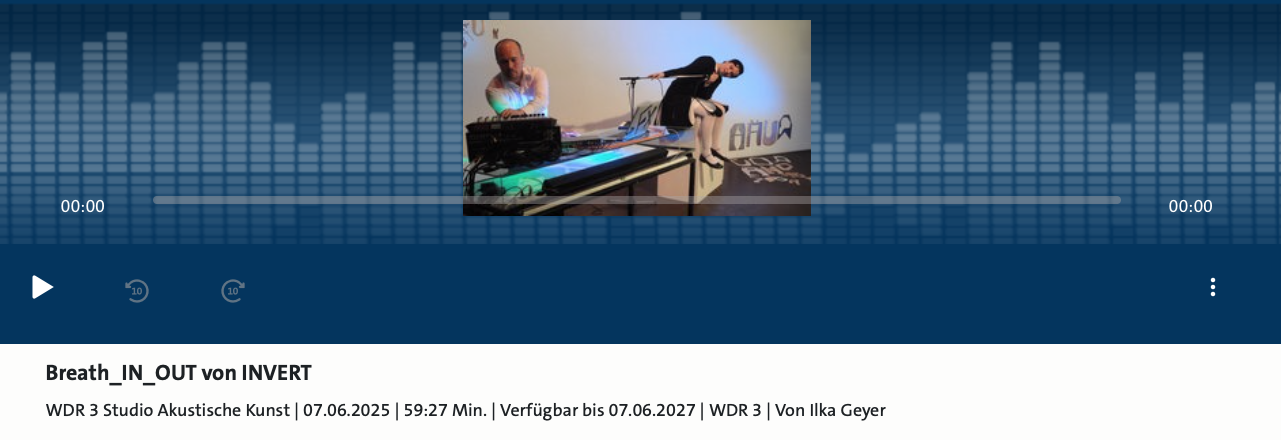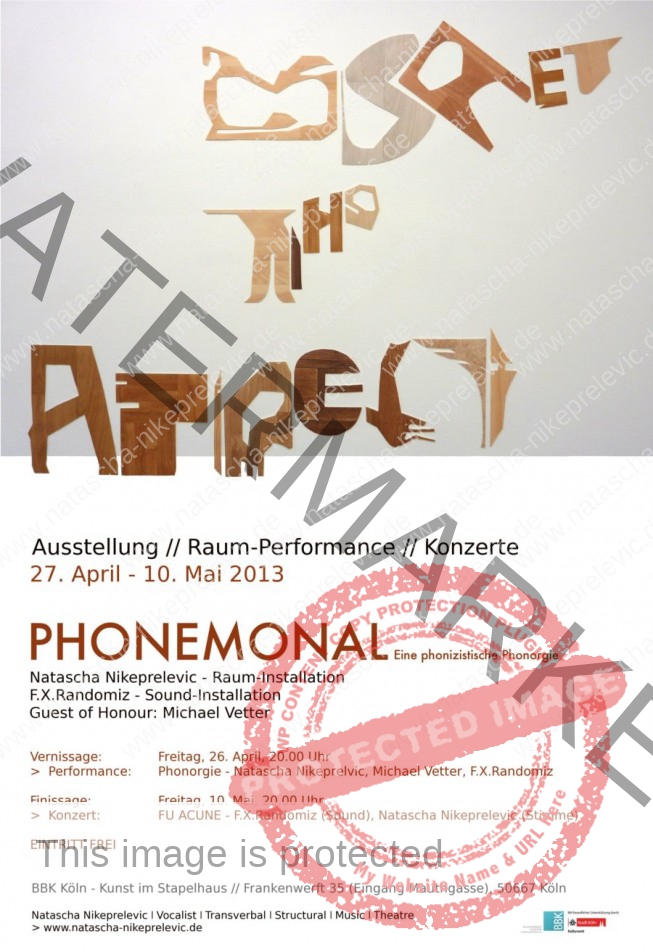INVERT
Natascha Nikeprelevic – Voice & F.X.Randomiz – Elektronics
 INVERT realizes audio-visual art in various contexts such as exhibitions, features, film, radio plays, music theater. Their storytelling is vertically instead of linearly. Within a specific field of experimentation, they do not research on the horizontal surface, but immerse their artistic expression in the vertical. They don’t move „forward“, but vertically inward. They analyze the conditions of spaces, texts, forms, rhythms in small parts and dissect and extract their structures down to their essence, basis, soul. They uncover this soul, turning the inside out with a poetic outcome, mixing and flavoring it with particles that were previously foreign, so that new forms, sounds, colors and characteristics emerge from it and it also takes on a new horizontal shape in the microspectrum of the vertical. INVERT creates a hitherto unheard condensate of language without semantics, of noise without effect, of sound without cliché, of voice beyond singing, of electronics without technoid mechanisms.
INVERT realizes audio-visual art in various contexts such as exhibitions, features, film, radio plays, music theater. Their storytelling is vertically instead of linearly. Within a specific field of experimentation, they do not research on the horizontal surface, but immerse their artistic expression in the vertical. They don’t move „forward“, but vertically inward. They analyze the conditions of spaces, texts, forms, rhythms in small parts and dissect and extract their structures down to their essence, basis, soul. They uncover this soul, turning the inside out with a poetic outcome, mixing and flavoring it with particles that were previously foreign, so that new forms, sounds, colors and characteristics emerge from it and it also takes on a new horizontal shape in the microspectrum of the vertical. INVERT creates a hitherto unheard condensate of language without semantics, of noise without effect, of sound without cliché, of voice beyond singing, of electronics without technoid mechanisms.
> New Sound-Art Production: Breath_IN_OUT
Broadcasted on Radio WDR 3 Studio Akustische Kunst.
Please listen with headphones and while lying down if possible.
![]() Listen here
Listen here
Cast:
Natascha Nikeprelevic – Director, Composition, Vocals & Speaking Voice, Koto Harp, Harmonium, and Ritual Instruments
F.X. Randomiz – Electronic Music, Composition & Realization, Synthesizer and Theremin
Guest: Goran Stevanovich – Accordion
Producer: WDR 3 Studio Akustische Kunst
Total Length: 46 minutes
Breath_IN_OUT is the second part of the INNENSCHAU trilogy conceived by Natascha Nikeprelevic, wich deals with the coronavirus pandemic.
Breath_IN_OUT focuses on the themes of breath and fear. The pandemic was characterized by fear. The fear of becoming ill, of not being able to breathe properly, of suffocating. The fear of dying. The fear that „it“ will never end. About the fear that the collective nightmare that divides society in two will continue. About the fear of having to make a choice.
Breath_IN_OUT doesn’t address the topic of pandemics in a documentary or political way, but rather narrates it on a structural level and poses the question: What causes fear in our breathing?
The audio piece therefore focuses on the respiratory system—as the entity primarily threatened by the virus. The protagonist is the oh-so-silent yet so existentially important servant of our vitality: breath.
In this three-act narrative, the mechanical-physical and the associated emotional process of breathing condense and develop into a breathing drama.
Content
Breath_IN_OUT transports the listener into a nightmarish otherworld. A kaleidoscope of delusional sequences unfolds, generating an almost manic form of expression through a penetrating focus on the (seemingly) simple moment of breathing. This manifests feelings of elemental hopelessness, especially through the exaggerated repetition of the same mantras „I breathe, you breathe, they breathe, we breathe“ and „breathe in – breathe out.“ It becomes clear that great physical and emotional turmoil ensues as soon as inhalation or exhalation becomes unbalanced. This results in shortness of breath, fear of death, and, with it, an unconditional will to live.
Breathing as a priority. Breathing as the „foundation of life.“ Breathing as a survival measure required every second.
In Breath_IN_OUT, there is a general fear of breathing. Am I breathing? Even while I sleep? Who or what is breathing inside me? Can I breathe? How do I breathe correctly? Am I breathing healthily? „Who will help me breathe?“ The fear of the next breath – and the fear that it could be the last. „Taking a breath is taking a breath. You just have to breathe it in. Then you’ve absorbed it. Get it. – Get this air. And you’ll live one breath longer,“ the piece says.
Inhaling and exhaling are interdependent, and both are processes in our bodies that we generally don’t pay much attention to. That’s a good thing, because breathing works best without our conscious intervention.
The pure act of breathing is addressed here in a shockingly direct and prominent way. After all, it is the beginning and end point of all our lives.
Breathing from the Latin: in-spiration: breathing in, letting the spirit in. The breathing process constantly oscillates between potential death (through not breathing) and life (through breathing again). And when „inspiration is over,“ as the piece says, that’s always a little death—at least in art.
Instruments
The audio piece is realized with breath, spoken word, singing, and vocal noise. These are embedded in electronic sounds, a theremin, and an accordion. Other instruments such as gongs, chimes, a temple fish, a sansula, a harmonium, and a koto harp lend the audio piece a distinctive sonic character at specific points
> Video-Teaser: Breath_In_Out
Breath_In_Out. Sound-Art-Production by & with Natascha Nikeprelevic (INVERT). Video-Teaser (German language. Full length: 45 minutes). I used my natural voice without any technical manipulation – as I am known to do. „Breath_In_Out“ is the second part of a trilogy I designed entitled: INNENSCHAU, (Introspection) which deals with the pandemic. The pandemic is characterized by fear. From the fear of falling ill, of not being able to breathe properly, of suffocating, of dying. The pandemic triggers the fear of death and puts the focus of our emotions and thoughts on our ability to breathe. Therefore, I reduced the essence of the piece to the elementary aspect of breathing or the process of breathing. So the protagonists of „Breath_In_Out“ are the moment of inhaling and exhaling. Both are processes in our body to which we generally pay almost no special attention. That’s a good thing, because breathing works best without our conscious intervention. „Breath In_Out“ describes the mechanical, physical and emotional process of breathing. The boundaries of breath noise, sound and song merge synesthetically with the electro-acoustic sounds. We become aware that all life begins and ends in the breath. The breath is the silent servant of our vitality. For those who don’t speak German: here an excerpt of the lyrics (Natascha Nikeprelevic, 2021/2): You breathe, we breathe. You breathe, he breathes, she breathes. He is breathing. We breathe. She breathes, we breathe, you breathe. You breathe, I breathe. We breathe. We breathe. We breathe, we breathe. We breathe. We breathe. We breathe, we breathe. We breathe! To breathe. Breath. We breathe. Breath.To breathe. Breath.
> New album // Invert Sound Lab: > Hör-Spiele < for two players
Composition by Michael Vetter (1977, Universal Edition Wien). Interpreters: Natascha Nikeprelevic: voice, recorder – F.X.Randomiz: electronics
Produktion (2021) // sponsored by Musikfonds.
![]()
> Sound-Art: Atem.Puls <
WDR 3 Studio Akustische Kunst
Audio-Excerpt: „Atem.Puls“. Part 1 of the Trilogy „Introspection“. Produktion 2021: WDR 3 open sound (47 Minutes).
> Interview: Natascha Nikeprelevic & F.X.Randomiz WDRadio Cologne:
Phonemonal (2016):
Exhibition Sound-Art: PHONEMONAL
Eine phonizistische Phonorgie –
Vom Un-Sinn einer Klangsprache und deren visueller Verlautbarung.
Natascha Nikeprelevic – Raum-Installation // F.X.Randomiz – Sound-Installation
Guest of Honour: Michael Vetter
Im Mai 2013 realisierte Natascha Nikeprelevic ein gross angelegtes Projekt als Synthese zwischen Raum und Musik in der Ausstellungshalle des BBK in Köln. Zwei Wochen war sie dort, gemeinsam mit F.X.Randomiz als Artist in Residenz mit: “< Phonemonal > Raum für Sinnfreiheit – Vom Un-Sinn einer Klangsprache und deren visueller Verlautbarung“ anzutreffen. Über die ganze Dauer der Ausstellung war eine Mehrkanal-Klanginstallation von F.X. Randomiz, zu hören, der die Stimme der Vokalistin in seine elektronischen Sound-Gebilde einband. Mehrere Live-Konzerte erweiterten die visuelle Raumgestaltung in ein intermediales Happening.




